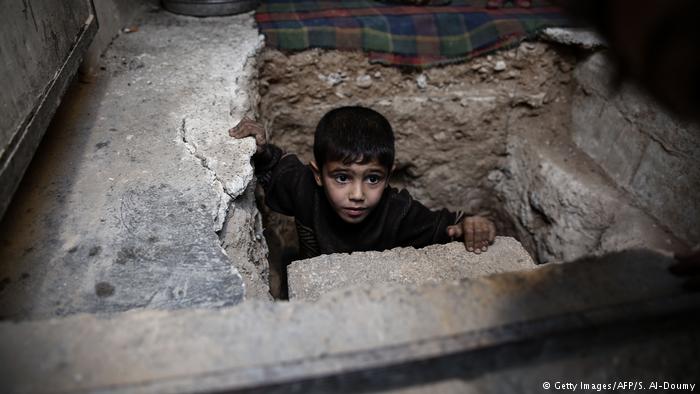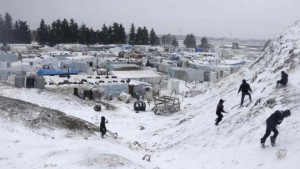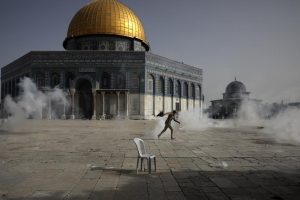Geneva, Sept (Kanaga Raja) – Civilians continue to bear the brunt of the ongoing hostilities in the armed conflict in the Syrian Arab Republic, which has now entered its ninth year, a United Nations Commission of Inquiry has said.


This is one of the main conclusions of the Independent International Commission of Inquiry on the Syrian Arab Republic in its latest report presented to the UN Human Rights Council on 17 September.
The Human Rights Council is currently holding its forty-second regular session from 9-27 September 2019.
The Commission of Inquiry is composed of Mr Paulo Sergio Pinheiro (Chair), Ms Karen Koning AbuZayd and Mr Hanny Megally.
In presenting the findings of the report, based on investigations conducted from 11 January to 10 July 2019, Commission Chair Mr Sergio Pinheiro said that the armed conflict in Syria, now in its ninth year, has been a study in crisis and missed opportunities.
As parties to this conflict have repeatedly pursued military objectives whatever the cost, civilian lives have been callously abused and lost.
Meanwhile, civilians have suffered indiscriminate bombing, shelling, detention, torture and death.
He noted that exactly one year ago, on 17 September 2018, an agreement between the Presidents of the Russian Federation and Turkey was reached to avert a crisis in Idlib.
This agreement sought to create a demilitarized buffer zone across the governorate, as well as in western Aleppo and northern Hama.
It resulted — for a time — in a respite for millions of civilians trapped in an impossible situation.
Sadly that pause was short-lived, said Mr Sergio Pinheiro.
Throughout north-western Syria, since April of this year, violence has escalated steadily and the demilitarized buffer zone has become a battleground.
Another humanitarian and human rights crisis has resulted from another wave of mass displacement of civilian residents fleeing conflict with inadequate humanitarian assistance available to meet their most urgent needs.
The Commission Chair also pointed out that after nearly four years of living in continuously deteriorating conditions and one-off aid deliveries, over 17,000 women, men and children left the Rukban camp following a series of evacuations organized between late March and May.
However, thousands still remain in the Rukban camp trapped in desperate conditions.
The situation in Al-Hol camp also remains desperate. Over 68,000 individuals are interned, 94 percent of them women and children.
Separated from the general population of the camp, some 11,000 family members of foreign ISIL fighters, including 3,500 children, are being housed away from food and health points that serve the other residents of the camp.
Many described being denied food and prevented from accessing medical care, including for their infant children.
They are in need of rehabilitation and reintegration. They require urgent comprehensive psycho-social rehabilitation, said Mr Sergio Pinheiro.
According to the Commission’s report, for nearly eight years, the Commission has chronicled violations of international human rights law and international humanitarian law in the Syrian Arab Republic.
Throughout this period, the Syrian conflict has generated myriad distinct conflict settings and, correspondingly, a variety of harsh realities for Syrian women, men and children.
Violations differ in scale and manner from one region to another, depending on the actors waging campaigns in a given region and those having control of it.
In many governorates, civilians continue to persevere despite enormous protection gaps. Those suffering the most belong to vulnerable groups, such as women, children, older persons, persons with disabilities and minorities.
As has been a hallmark of the conflict, civilians continue to bear the brunt of the ongoing hostilities, including in Idlib, northern Hama, Ladhiqiyah and western Aleppo.
Indeed, combat operations escalated during the reporting period, destroying infrastructure essential to the survival of the civilian population, including hospitals, markets, educational facilities and agricultural resources and forcing hundreds of thousands to flee.
Meanwhile, civilians in the east of the country (Dayr al-Zawr) witnessed the winding down of large-scale military operations by the United States-led international coalition and the Syrian Democratic Forces (SDF), which had led to the near complete destruction of towns and villages.
Waves of displacements ensued, in which tens of thousands fleeing the battle zones in Dayr al-Zawr sought refuge in makeshift settlements, straining the already severely overstretched humanitarian resources.
According to the Commission, the displacements have resulted not only in limited access to resources for civilians, but also an uneven distribution of services throughout the country.
Furthermore, prolonged displacements remain unresolved, in particular in large camp settings, including Al-Hol, Ain-Issa, Al-Roj, Atma and Rukban camps, in which tens of thousands of civilians remain confined in desperate conditions amid wastelands.
Countless other Syrian women, men and children have endured persecution. In Idlib, for example, where Levant Liberation Organization (Hay’at Tahrir al-Sham) terrorists are operating, civilians continue to be unlawfully detained or kidnapped, and often, tortured for expressing political dissent.
In government-controlled areas, civilians, including recent returnees, have been arbitrarily arrested and detained, harassed, mistreated and tortured.
Meanwhile, the scope and scale of arbitrary detentions, kidnappings and enforced disappearances, together with the destruction of vital infrastructure and the lack of effective service provision and civil documentation demonstrate that numerous challenges persist regarding the sustainable return of internally displaced persons and refugees.
The Commission said that during the period under review, major military operations were limited mainly to two operational theatres, namely Idlib and Dayr al-Zawr Governorates.
Elsewhere, countrywide insurgencies emerged, giving rise to general insecurity and low-intensity conflicts.
Geopolitical tensions also continued and, in some situations, posed a threat to regional peace and security.
During the period under review, Idlib, northern Hama, Ladhiqiyah and western Aleppo Governorates were embroiled in military escalation and a surge of violence against civilians.
Despite the establishment of a demilitarized zone along this axis, pro-government forces sought to oust the Levant Liberation Organization and affiliated armed groups from the area.
After more than seven years of brutal armed conflict, the most salient feature of the hostilities throughout the Syrian Arab Republic remains the wilful non-compliance with international law.
Moreover, said the Commission, all warring parties continue to ignore or deny arbitrarily assurances of protection, including guarantees of sustained and unhindered humanitarian assistance to vulnerable civilian populations.
Meanwhile, the deliberate targeting of civilian-inhabited areas and protected objects flared up during the period under review.
The Commission said its findings clearly indicate that there are varying situations concerning the rule of law in the different areas of the country and that, in general, citizens still feel unsafe and unprotected by the State.
For example, citizens are prone to abduction for ransom or for political gain, extortion and acts of retribution.
Those who have lost their properties or their livelihoods have little recourse to justice, while those in detention risk ill-treatment and, in some instances, execution.
Following the cessation of major military operations in Hajin, the Commission said it continued to investigate the final stages of operation Al-Jazeera Storm, conducted by SDF with support from the international coalition.
The campaign was directed against the remaining ISIL pockets in areas south of Hajin, in particular in and around Baghuz.
Throughout the operations, battles were characterized by hundreds of coalition air strikes, heavy artillery bombardment by SDF, coalition forces and Iraqi forces through cross-border operations, as well as, on occasion, shelling originating from territory controlled by the Government of the Syrian Arab Republic.
Entrenched in fortified bases and among hundreds of civilians, including women and children, ISIL elements responded with anti-tank guided missiles, sniper fire and vehicle-born improvised explosive devices.
The Commission said it continued its investigations into a series of air strikes carried out by the United States-led international coalition during operation Al-Jazeera Storm, which resulted in a high number of civilian casualties.
The Commission recalled numerous previous attacks by the United States-led international coalition that resulted in death or injury to civilians.
Furthermore, the Commission noted the isolated location of the targeted object, the high number of civilian casualties who were overwhelmingly children and the specific statements of eyewitnesses indicating the exclusive presence of civilians at the scene of the incident, all coinciding with the apparent absence of a military target in the area of the attack.
The Commission found that there are reasonable grounds to believe that international coalition forces may not have directed their attacks at a specific military objective, or failed to do so with the necessary precaution.
Launching indiscriminate attacks that result in death or injury to civilians amounts to war crime in cases in which such attacks are conducted recklessly, it said.
Overall, security conditions within Afrin and adjacent districts remained dire throughout the reporting period.
While infighting between rival armed groups persisted in 2019, a formal security structure under the so-called Syrian National Army framework, comprising most Olive Branch factions, had consolidated control over the region.
The armed factions within this framework have de facto carved up the province in geographic zones of influence.
Local residents consistently described chaotic security conditions, a general absence of the rule of law and repeated cases of kidnappings, abductions, torture, extortion and assassinations.
Such human rights violations by Syrian National Army factions during the period under review have followed a persistent and clearly discernible pattern, said the Commission.
Throughout areas under the control of government forces, including Rif Dimashq and Dar’a Governorates, the Commission continued to receive accounts of arbitrary detention and enforced disappearances.
In Yabrud and Qalamun (Rif Dimashq), for example, dozens of men aged between 20 and 25 years were arrested and forcibly disappeared during the period under review.
MASSIVE DISPLACEMENT AND GENDERED HARM
According to the Commission, the Syrian conflict has displaced approximately 13 million civilians, including 6.7 million refugees and 6.2 million internally displaced women, men and children.
Uprooted from their homes and forced to leave everything behind, many continue to endure serious violations of their basic human rights.
Attacks against medical and educational facilities, in addition to constraints on humanitarian access and the destruction of food supplies, have further compounded the plight of those fleeing and exacerbated their vulnerabilities.
The majority of those displaced are women and children who remain adversely affected by the conflict.
In the context of displacement and beyond, women and girls face higher risks of exploitation and abuse.
Persons with disabilities and older persons encounter significant protection and assistance concerns when relocated to settlements in which access to services is severely limited.
Displacement, moreover, amplifies pre-existing gender inequalities and exacerbates gendered harms, said the Commission.
The Commission also noted that rape and other forms of sexual violence continued to occur during the period under review.
Sexual violence has played a prominent role in the conflict, owing to the fear and threat of rape and the violence committed.
The Commission said it is currently reviewing reports of rape and sexual violence against women, including returnees, men and lesbian, gay, bisexual, transgender and intersex civilians that have allegedly been perpetrated in government-controlled areas. Investigations are ongoing.
Gendered harms also manifest themselves in the exercise of key rights. In the Syrian Arab Republic, female- headed households have been rapidly increasing as a result of the widespread and systematic arrest and disappearance of men and boys above the age of 15 years by pro-government forces, primarily government forces.
Women and girls with physical and intellectual disabilities have also been adversely affected by the conflict, said the Commission. – Third World Network
Published in SUNS #8980 dated 19 September 2019




